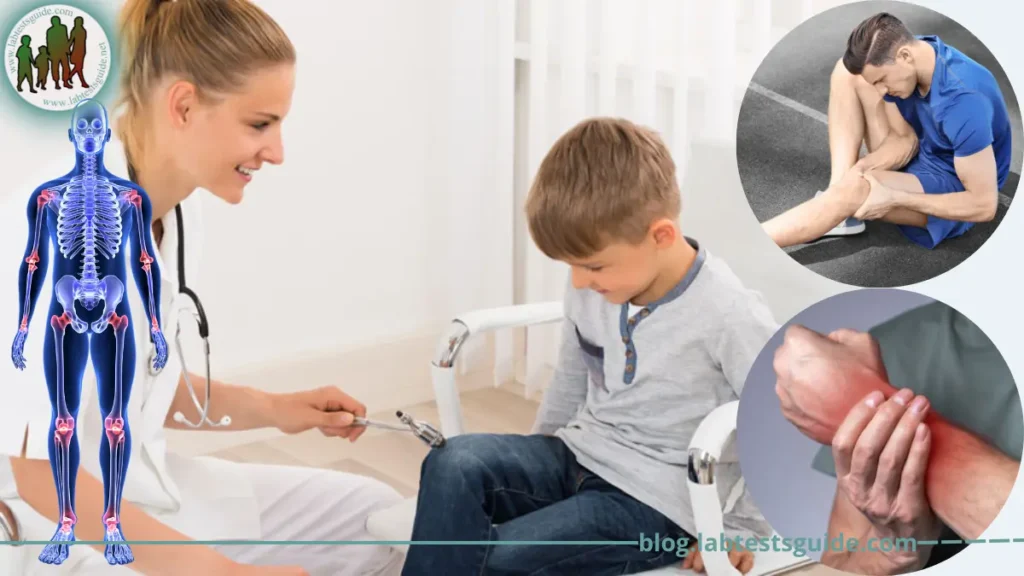Joint pain can be a common concern for boys, especially as they engage in physical activities and sports. It is essential to prioritize joint health and take preventive measures to minimize the risk of joint pain and maintain an active lifestyle. This guide provides valuable tips for boys to prevent and manage joint pain effectively. By following these recommendations, boys can take proactive steps to protect their joints, promote overall well-being, and continue enjoying their favorite activities without discomfort or limitations.

Maintain a Healthy Weight:
Here are some key points to consider.
- Engage in Regular Exercise: Excess weight can increase the risk of joint pain and contribute to conditions like osteoarthritis. By maintaining a healthy weight, you can reduce the strain on your joints and promote their long-term health.
- Balanced Diet: Focus on consuming a balanced diet that includes a variety of fruits, vegetables, whole grains, lean proteins, and healthy fats. Avoid excessive consumption of sugary, processed, and fried foods, as they can contribute to weight gain and inflammation.
- Portion Control: Pay attention to portion sizes to avoid overeating. This helps to manage calorie intake and maintain a healthy weight.
- Regular Physical Activity: Engage in regular exercise and physical activities that help burn calories and support weight management. Choose activities that are joint-friendly, such as swimming, cycling, or brisk walking.
- Seek Professional Guidance: If you are struggling with weight management, consider consulting a healthcare professional or a registered dietitian. They can provide personalized guidance and create a suitable plan to achieve and maintain a healthy weight.
By maintaining a healthy weight, you can reduce the strain on your joints, improve their function, and lower the risk of joint pain and associated conditions. Remember, a combination of a healthy diet and regular exercise is key to achieving and maintaining a healthy weight.
Engage in Regular Exercise:
Here are some key points to consider.
- Low-Impact Activities: Choose exercises and activities that are gentle on the joints, such as swimming, cycling, yoga, or tai chi. These activities provide cardiovascular benefits without putting excessive stress on the joints.
- Strengthening Exercises: Incorporate exercises that target the muscles supporting the joints, such as leg squats, lunges, and resistance training. Strong muscles provide better support and stability to the joints, reducing the risk of pain and injuries.
- Flexibility and Range of Motion Exercises: Include stretching exercises in your routine to improve flexibility and maintain a good range of motion in your joints. Stretching can help alleviate stiffness and reduce the risk of joint pain.
- Warm-Up and Cool-Down: Prior to any exercise or physical activity, make sure to warm up your body with light exercises or a brisk walk. This helps to increase blood flow to the muscles and prepares the joints for activity. Similarly, end your exercise session with a cool-down routine and gentle stretches to help the body recover and reduce post-exercise stiffness.
- Gradual Progression: Start slowly and gradually increase the intensity and duration of your workouts. Sudden or excessive exertion can strain the joints and lead to pain or injuries. Listen to your body and progress at a pace that feels comfortable and sustainable.
- Proper Technique: Use correct form and technique during exercises to minimize stress on the joints. If you are unsure about the proper technique, consider seeking guidance from a qualified fitness professional or coach.
- Rest and Recovery: Allow your body enough time to rest and recover between workouts. This is crucial for the repair and rebuilding of tissues and helps prevent overuse injuries and joint pain.
Remember, it’s important to choose activities that you enjoy and that fit your abilities and interests. Consistency is key when it comes to exercise, so aim for regular physical activity to keep your joints healthy and reduce the risk of joint pain.
Warm-Up and Stretch:
Here are some important points to consider.
- Importance of Warm-Up: Before starting any physical activity or exercise, spend 5-10 minutes on a warm-up routine. This can include light aerobic exercises like jogging in place, jumping jacks, or cycling. The aim is to increase your heart rate, warm up your muscles, and improve blood circulation to the joints.
- Dynamic Stretching: After the warm-up, incorporate dynamic stretching exercises. These involve moving your joints through a full range of motion in a controlled manner. Examples include arm circles, leg swings, or torso twists. Dynamic stretching helps to improve joint mobility, increase muscle flexibility, and prepare your body for the specific activity you’re about to engage in.
- Targeted Stretches: Perform targeted stretches for the major muscle groups involved in your activity. Focus on areas like your calves, quadriceps, hamstrings, hip flexors, and shoulders. Hold each stretch for 15-30 seconds and repeat on both sides. Avoid bouncing or jerking movements during stretches, as they can cause injury.
- Proper Technique: Pay attention to your form and technique during stretches. Maintain good posture and perform the stretches with control. Avoid pushing yourself beyond your comfortable range of motion, as it should feel like a gentle pull and not painful.
- Cooling Down: After completing your exercise or activity, take the time for a cool-down period. This allows your body to gradually return to its resting state and helps prevent muscle stiffness. Include gentle stretches for the major muscle groups and deep breathing exercises to promote relaxation.
- Consistency: Make warm-up and stretching exercises a regular part of your fitness routine. Consistency is key to reaping the benefits and reducing the risk of joint pain or injuries.
Remember, warm-up and stretching exercises should be tailored to your specific needs and the activities you’ll be performing. If you’re unsure about the best warm-up routine or specific stretches, consult a fitness professional or seek guidance from a coach who can provide personalized recommendations.
Use Proper Techniques:
Here are some important points to consider.
- Learn Proper Form: When engaging in sports, exercises, or any physical activity, take the time to learn and understand the proper form and technique. This includes understanding the correct body mechanics, alignment, and movement patterns for each activity.
- Seek Guidance: If you’re new to a particular sport or exercise, consider seeking guidance from a qualified coach or instructor. They can provide valuable insights and correct any improper form or technique, helping you minimize stress on your joints and maximize efficiency.
- Start Slowly: When trying a new activity or exercise, start at a beginner level and gradually progress. Allow your body time to adapt and build strength and endurance. Avoid the temptation to push yourself beyond your limits too quickly, as it can lead to injuries and joint pain.
- Focus on Core Strength: A strong core (abdominal and back muscles) provides stability and support to the entire body, including the joints. Incorporate exercises that target the core muscles, such as planks, bridges, or Pilates, into your fitness routine.
- Use Proper Equipment: Ensure that you have the right equipment and gear for your activity. This may include wearing appropriate footwear, protective gear (helmets, pads), or using equipment that is properly adjusted and suited to your body size and mechanics.
- Listen to Your Body: Pay attention to any discomfort, pain, or unusual sensations during physical activity. If you experience joint pain, stop the activity and assess the cause. Pushing through pain can lead to further injury and complications.
- Rest and Recovery: Allow your body sufficient time to rest and recover between workouts or intense activities. This allows your joints and muscles to heal and regenerate, reducing the risk of overuse injuries and chronic joint pain.
- Cross-Train: Engage in a variety of activities and exercises to avoid repetitive stress on the same joints. Cross-training helps distribute the workload among different muscle groups and reduces the risk of overburdening specific joints.
Remember, proper techniques not only help prevent joint pain but also optimize performance and enhance overall fitness. Don’t hesitate to consult with professionals, such as coaches, trainers, or physical therapists, who can provide guidance and support in using correct techniques for your specific activities.
Take Breaks and Rest:
Here are some important points to consider:
- Avoid Overexertion: Engaging in intense physical activities for prolonged periods without breaks can put excessive strain on your joints. Pace yourself and listen to your body’s signals of fatigue or discomfort.
- Schedule Regular Breaks: During extended periods of physical activity, schedule regular breaks to rest and recover. This allows your joints to rest and reduces the risk of overuse injuries.
- Modify Intensity: If you’re engaging in activities that involve repetitive joint movements or high impact, consider alternating between high-intensity and low-intensity exercises. This helps give your joints a break while still maintaining an active routine.
- Adequate Sleep: Getting enough sleep is essential for overall recovery and joint health. During sleep, your body repairs tissues, including those in your joints. Aim for the recommended amount of sleep for your age group.
- Listen to Your Body: Pay attention to any signs of joint pain, discomfort, or swelling. If you experience persistent joint pain during or after physical activities, it may be a sign that you need to take a break or modify your routine. Consult with a healthcare professional if joint pain persists.
- Rest Days: Incorporate rest days into your fitness routine. Rest days allow your body and joints to recover and rebuild, reducing the risk of overuse injuries and joint pain. Use this time for gentle stretching or low-impact activities that promote relaxation.
- Use Ice or Heat Therapy: If you experience joint soreness or inflammation after intense activities, consider using ice or heat therapy. Applying ice packs or using heat packs can help reduce swelling, relieve pain, and promote healing.
- Hydration: Stay adequately hydrated throughout the day. Proper hydration helps maintain the health and lubrication of your joints, reducing the risk of joint pain.
Remember, rest and recovery are just as important as physical activity when it comes to maintaining joint health. By allowing your joints time to rest and heal, you can prevent overuse injuries, reduce joint pain, and optimize your overall performance.
Use Protective Gear:
Here are some important points to consider.
- Assess the Activity: Evaluate the specific activity or sport you’ll be participating in and identify the potential risks to your joints. Different activities may require different types of protective gear.
- Head Protection: If you engage in sports or activities that pose a risk of head injuries, such as cycling, skateboarding, or contact sports, always wear a properly fitted helmet to protect your head and reduce the risk of concussions or other head-related injuries.
- Joint-Specific Gear: Depending on the activity, consider using joint-specific protective gear such as knee pads, elbow pads, or wrist guards. These can provide cushioning, support, and protection to vulnerable joints during high-impact activities or falls.
- Footwear: Wear proper footwear that is designed for the specific activity you’re engaging in. Good-quality athletic shoes with adequate cushioning and support can help absorb shock and reduce stress on the joints, especially the ankles and knees.
- Correct Fit: Ensure that your protective gear fits properly and is adjusted according to the manufacturer’s guidelines. Ill-fitting gear may not provide optimal protection and can hinder your movements or even cause discomfort.
- Regular Inspection: Regularly inspect your protective gear for any signs of wear and tear. Replace any damaged or worn-out gear to maintain its effectiveness.
- Follow Safety Guidelines: Adhere to safety guidelines and rules specific to the activity or sport you’re participating in. This includes following proper techniques, respecting the rules of the game, and being aware of your surroundings to minimize the risk of joint injuries.
- Communication: If you’re participating in team sports, communicate with your teammates about safety measures and ensure everyone is on the same page regarding protective gear and safety protocols.
- Remember, protective gear is designed to reduce the risk of injury but doesn’t guarantee complete prevention. It is essential to use your gear in conjunction with proper techniques, awareness, and adherence to safety guidelines to effectively protect your joints and prevent joint pain or injuries.
Maintain Proper Posture:
Here are some key points to consider.
- Stand Tall: When standing, imagine a straight line extending from your earlobe through your shoulder, hip, knee, and ankle. Keep your body aligned along this line, with your shoulders relaxed and your chin slightly tucked in.
- Sit with Support: When sitting, choose a chair that provides adequate support for your lower back. Sit with your back against the chair, feet flat on the floor, and knees at a 90-degree angle. Use a cushion or lumbar roll if needed to maintain the natural curve of your lower back.
- Avoid Slouching: Whether sitting or standing, avoid slouching or hunching forward. Slumping posture can strain the muscles, ligaments, and joints, leading to pain and discomfort. Instead, engage your core muscles to support a more upright posture.
- Take Breaks from Prolonged Sitting: If you have a sedentary lifestyle or work involves prolonged sitting, take regular breaks to stand up, stretch, and move around. This helps alleviate stress on the joints and reduces the risk of stiffness and pain.
- Ergonomic Workspace: If you work at a desk or use a computer, ensure your workspace is set up ergonomically. Position your computer screen at eye level, adjust your chair and desk height to maintain proper alignment, and use ergonomic accessories like a supportive chair, keyboard, and mouse.
- Lift Properly: When lifting objects, use your leg muscles instead of your back. Bend at your knees and hips, keep the object close to your body, and avoid twisting or jerking motions. This technique helps protect your spine and reduces the risk of strain or injury to your joints.
- Exercise for Postural Strength: Incorporate exercises that strengthen the muscles that support good posture, such as core exercises, back extensions, and shoulder strengthening exercises. A strong and balanced musculature helps maintain proper alignment and reduces the risk of postural imbalances that can lead to joint pain.
- Mindful Body Awareness: Develop awareness of your posture throughout the day. Regularly check in with your body to ensure you’re maintaining proper alignment and making necessary adjustments as needed.
Remember, maintaining proper posture is a habit that requires practice and mindfulness. By consciously adopting good posture habits, you can reduce the strain on your joints, improve your overall alignment, and minimize the risk of joint pain and associated discomfort.
Use Joint-Friendly Techniques:
Here are some important points to consider.
- Low-Impact Exercises: Choose exercises that are gentle on the joints, such as swimming, cycling, or using an elliptical machine. These activities provide cardiovascular benefits without putting excessive stress on the joints.
- Modify High-Impact Activities: If you enjoy high-impact activities like running or jumping, consider modifying them to reduce the impact on your joints. For example, switch to a softer surface like grass or use proper footwear with adequate cushioning and shock absorption.
- Range of Motion Exercises: Engage in exercises that promote joint mobility and flexibility. This can include gentle stretching, yoga, or tai chi. Focus on maintaining a full range of motion in your joints to improve joint health and prevent stiffness.
- Proper Lifting Techniques: When lifting weights or heavy objects, use proper form and technique to protect your joints. Bend your knees, engage your core, and lift with your leg muscles rather than straining your joints.
- Joint-Specific Strength Training: Incorporate strength training exercises that specifically target the muscles supporting your joints. Strengthening these muscles helps stabilize the joints and reduce the risk of joint pain and injuries. Work with a qualified fitness professional to develop a joint-friendly strength training routine.
- Listen to Your Body: Pay attention to any pain, discomfort, or swelling in your joints during or after physical activity. If you experience joint pain, modify or discontinue the activity and consult with a healthcare professional if the pain persists.
- Use Supportive Gear: Depending on the activity, consider using supportive gear to reduce stress on your joints. This can include using knee braces, ankle braces, or wrist supports during activities that put strain on those joints.
- Gradual Progression: When starting a new exercise or activity, gradually increase the intensity, duration, or resistance over time. Sudden increases in intensity or volume can put excessive stress on the joints, leading to pain or injuries.
Remember, taking a joint-friendly approach to physical activities is crucial for protecting your joints and promoting their long-term health. By using proper techniques, modifying activities when necessary, and listening to your body, you can reduce the risk of joint pain and enjoy a more sustainable and enjoyable fitness routine.
Stay Hydrated:
Here are some key points to consider.
- Importance of Hydration: Water is essential for maintaining the health and function of your joints. It helps cushion and lubricate the joints, allowing them to move smoothly and reducing friction. Dehydration can lead to decreased joint lubrication and increased joint stiffness.
- Drink Ample Water: Make sure to drink an adequate amount of water throughout the day. The exact amount can vary depending on factors such as your activity level, climate, and individual needs. As a general guideline, aim to drink at least 8 glasses (64 ounces) of water per day.
- Monitor Urine Color: Monitoring the color of your urine can be a helpful indicator of your hydration status. Ideally, your urine should be a pale, straw-like color. If it’s dark yellow or amber, it may indicate dehydration and the need to drink more water.
- Hydrate Before, During, and After Exercise: When engaging in physical activity, it’s important to hydrate properly. Drink water before, during, and after your workouts to replenish fluids lost through sweat. If you’re engaging in prolonged or intense exercise, consider sports drinks that contain electrolytes to help replace the minerals lost through sweat.
- Consider Your Environment: Hot and humid environments can increase fluid loss through sweat, so it’s important to increase your water intake accordingly. Additionally, if you’re at high altitudes, your body may require more water due to increased respiratory water loss.
- Hydration and Joint Health: Adequate hydration supports the health of your cartilage, which is the connective tissue that cushions the joints. Staying hydrated can help maintain the integrity and elasticity of the cartilage, reducing the risk of joint pain and stiffness.
- Limit Dehydrating Substances: Certain substances, such as alcohol and caffeinated beverages, can have a diuretic effect and increase fluid loss. While moderate consumption may not pose significant issues, it’s important to balance these drinks with water intake to maintain hydration.
- Incorporate Hydrating Foods: Along with drinking water, you can also increase your hydration by consuming foods with high water content. Fruits and vegetables like watermelon, cucumbers, oranges, and strawberries are excellent choices that contribute to both hydration and overall nutrition.
Remember, staying hydrated is a simple yet essential aspect of joint health and overall well-being. By maintaining proper hydration levels, you can support the health and function of your joints, reduce the risk of joint pain, and promote optimal physical performance.
Listen to Your Body:
Here are some key points to consider:
- Recognize Pain Signals: Pay attention to any pain, discomfort, or stiffness in your joints. These are warning signals that something may be wrong. Ignoring or pushing through pain can exacerbate the issue and lead to further damage. Instead, listen to your body and take appropriate action.
- Rest When Needed: If you experience joint pain or fatigue during physical activities, it’s important to take breaks and rest. Resting allows your joints to recover and reduces the risk of overuse injuries. Don’t feel guilty about taking time off when your body needs it.
- Modify Activities: If certain activities or exercises cause joint pain or discomfort, consider modifying or finding alternatives. This may involve adjusting the intensity, duration, or technique of the activity to make it more joint-friendly. For example, opting for low-impact exercises instead of high-impact ones.
- Respect Your Limits: Each person has different physical abilities and limitations. Be realistic about what your body can handle and don’t compare yourself to others. Pushing yourself beyond your limits can increase the risk of injury and joint pain. Gradually progress at a pace that is comfortable for you.
- Balance Activity and Rest: Find the right balance between physical activity and rest. Overdoing it with intense workouts or prolonged periods of inactivity can both be detrimental to your joints. Strive for a well-rounded routine that includes a variety of activities and allows for sufficient rest and recovery.
- Communicate with Healthcare Professionals: If you’re experiencing persistent or worsening joint pain, consult with a healthcare professional. They can provide a proper diagnosis, offer treatment options, and guide you in managing your joint pain effectively.
- Learn from Experience: Over time, you’ll develop a better understanding of your body and its limitations. Pay attention to how certain activities, movements, or lifestyle factors affect your joints. Use this knowledge to make informed decisions and adjustments in your daily routines.
- Prioritize Self-Care: Take care of your overall health and well-being. This includes getting enough sleep, managing stress levels, maintaining a balanced diet, and practicing relaxation techniques. When your body is in good overall health, it’s better equipped to handle and recover from joint-related issues.
Remember, your body communicates its needs and limitations through pain and discomfort. By listening to your body, you can make informed decisions, adapt your activities, and take the necessary steps to prevent and manage joint pain effectively.
Conclusion:
In conclusion, preventing and managing joint pain as a boy requires a multifaceted approach that focuses on various aspects of your lifestyle and habits. By implementing the tips discussed in this table of contents, you can promote joint health, reduce the risk of joint injuries, and minimize joint pain:
Maintain a healthy weight to alleviate stress on your joints.
Engage in regular exercise, including low-impact activities, to strengthen muscles and support joint stability.
Warm up and stretch before physical activities to increase flexibility and reduce the risk of injury.
Use proper techniques and form during exercises and activities to avoid unnecessary strain on your joints.
Take breaks and rest when needed to allow your joints time to recover and prevent overuse injuries.
Use protective gear, such as helmets, pads, and supportive footwear, to minimize the risk of joint injuries during sports and other activities.
Maintain proper posture to reduce strain on your joints, especially in the spine, neck, and shoulders.
Stay hydrated to support joint lubrication and overall joint health.
Listen to your body’s signals of pain and discomfort, and make necessary modifications or seek medical advice when needed.
Remember, these tips are general guidelines, and it’s important to consult with healthcare professionals, such as doctors, physical therapists, or trainers, for personalized advice and recommendations.
By incorporating these preventive measures and making informed choices, you can promote healthy joint function, minimize the risk of joint pain, and maintain an active and fulfilling lifestyle as a boy.






